2017 | Book | 1. edition
Interactive Theorem Proving
8th International Conference, ITP 2017, Brasília, Brazil, September 26–29, 2017, Proceedings
Editors: Mauricio Ayala-Rincón, César A. Muñoz
Publisher: Springer International Publishing
Book Series : Lecture Notes in Computer Science
